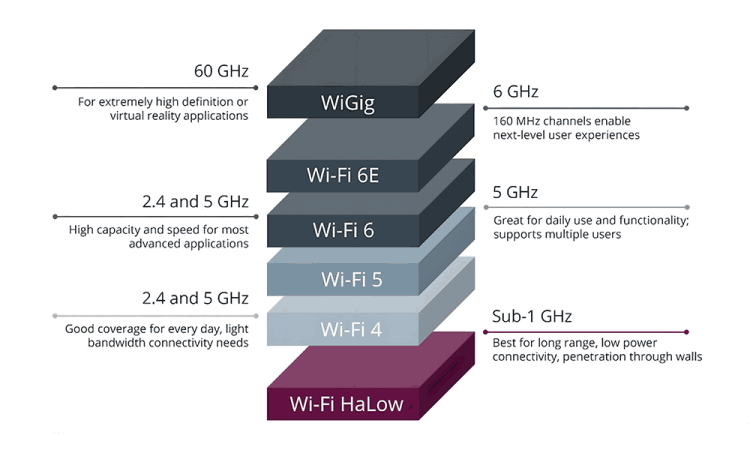
Wi-Fi HaLow is more than just another iteration of the classic Wi-Fi standard that is now seeing the introduction of high-capacity variants such as WiGig and Wi-Fi 6E. Instead, Wi-Fi HaLow introduces a low power connectivity option that, in contrast to other Wi-Fi options, offers greater range of approximately 1 km. This opens up a raft of IoT use cases, especially for small campus-based deployments such as academic and research institutions, industrial sites and offices. In addition, a wide range of industrial, smart city and smart building, and agricultural applications can be supported.

Wi-Fi HaLow operates in spectrum below 1 GHz, which enables good signal penetration through walls and other obstacles. The low power demands of the technology enable Wi-Fi HaLow devices to be powered by coin-sized cell batteries for months and, in some cases, for years. In addition, because Wi-Fi HaLow is part of the Wi-Fi family, there is no need for proprietary hubs and gateways.
Advantages of Wi-Fi HaLow
By being able to tap into the maturity of the Wi-Fi ecosystem, Wi-Fi HaLow has several advantages over other low power technologies. Beyond the extended range, Wi-Fi HaLow offers several device power saving modes, native IP support and the latest in Wi-Fi security. The technology also delivers Wi-Fi attributes such as multi-vendor interoperability and ease of setup without disrupting existing Wi-Fi networks.
Wi-Fi HaLow has a performance sweet spot, offering up to 78 Mbps capacity over short distances with 150 Kbps achievable at up to 1 km. This makes it a real alternative to LoRaWAN, Zigbee, Bluetooth Low Energy and even NB-IoT. Importantly, the data rate is sufficient for streaming video over the network, setting HaLow apart from LoRa, Sigfox and NB-IoT.
The real value comes in the radically extended battery life that can be achieved with Wi-Fi HaLow. The technology introduces enhanced sleep modes such as Target Wake Time and Restricted Access Window so the devices can conserve energy and sleep, while not responding to irrelevant network traffic. Wi-Fi HaLow also minimises data collision with its listen-before-talk capability that allows high network utilisation among multiple devices.
An IMEC comparison study published by Wi-Fi Alliance has uncovered that battery life for Wi-Fi HaLow devices, using 500 mAh batteries at ten-minute transmission intervals, can be 3,15 years; far exceeding the lifespans of other LPWAN technologies.
This attribute, combined with longer range and its relatively high performance, makes Wi-Fi HaLow a compelling option for several use cases. Outdoor cameras, for example, can be supported by HaLow because low-power cameras can be installed without their signal being blocked by trees or other obstacles. This could be used to monitor cattle on a farm or to help manage multi-dwelling units, including underground car parking areas.
The versatile nature of Wi-Fi HaLow is a key reason why, in spite of being ratified in 2016, it is now being adopted by numerous IoT projects. The technology’s ability to offer sufficient throughput over 1 km ranges with very low power consumption, and to bring the benefits of being part of the wider Wi-Fi ecosystem to organisations, has ignited interest and is adding Wi-Fi HaLow to developers’ option lists.
| Tel: | +27 11 781 2029 |
| Email: | [email protected] |
| www: | www.icorptechnologies.co.za |
| Articles: | More information and articles about iCorp Technologies |

© Technews Publishing (Pty) Ltd | All Rights Reserved